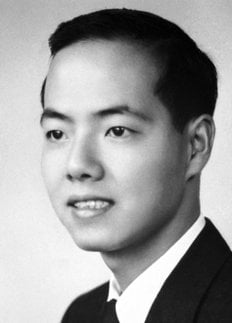Tsung-Dao Lee
Biographical

Tsung-Dao (T.D.) Lee was born in Shanghai, China, on November 24, 1926, the third of six children of Tsing-Kong Lee and Ming-Chang Chang.
He received most of his high school education in Shanghai. During 1943-1944, he attended the National Chekiang University in Kweichow Province. In 1945, he attended the National Southwest Associated University in Kunming, Yunnan Province. Lee’s early aptitude for physics was recognized and encouraged by Professor Ta-You Wu. After completing only his sophomore year at Southwest Associated University, Lee received a Chinese government fellowship for graduate study in the United States. From 1946-50, Lee studied at the University of Chicago where Enrico Fermi selected Lee to be his doctoral student. In 1950, Lee received his Ph.D. degree on his thesis Hydrogen Content of White Dwarf Stars.
During the years 1950-53, Lee worked as a research associate and lecturer at Yerkes Astronomical Observatory, Wisconsin; at the University of California at Berkeley, and at the Institute for Advanced Study at Princeton, N.J.
Lee was then fast becoming a widely known scientist, especially for his work in elementary particles, statistical mechanics, field theory, astrophysics, condensed matter physics and turbulence, having solved several problems of long standing and great complexity. Dr. J. Robert Oppenheimer praised him as one of the most brilliant theoretical physicists then known, whose work was characterized by “a remarkable freshness, versatility, and style”.
In 1953, Lee joined Columbia University as an Assistant Professor. His first work was on the renormalizable field theory model, better known as the Lee Model. He was successively promoted to Associate Professor in 1955 and Professor in 1956. At age 29, Lee was then the youngest-ever full professor in Columbia University’s faculty history. In 1957, when awarded the Nobel Prize at barely 31 years of age, Lee became the second youngest scientist ever to receive this distinction. (The youngest was Sir Lawrence Bragg, who shared the Physics Prize with his father in 1915, at the age of twenty-five).
Lee has published over 300 scientific papers and several books.
Among Lee’s many prizes and awards are the Albert Einstein Award in Science, Galileo Galilei Medal, G. Bude Medal, Science for Peace Prize, China National-International Cooperation Award, New York City Science Award, New York Academy of Science Award, Order of Merit Grande Ufficiale from Italy; and the Order of the Rising Sun, Gold and Silver Star from Japan. He received honorary doctorates, professorships, lectureships and trusteeships from over thirty universities worldwide. Lee is a member of the National Academy of Sciences, the American Academy of Arts and Sciences, the American Philosophical Society, Academia Sinica, Academia Nazionale del Lincei, the Chinese Academy of Sciences, the Third World Academy of Sciences, and the Pontifical Academy of Sciences.
Lee married Jeannette Hui-Chun Chin in 1950. They have two sons, James and Stephen.
* This autobiography was provided by the Laureate in December 2007.
Tsung-Dao Lee died on 4 August 2024.
Copyright © The Nobel Foundation 2007Nobel Prizes and laureates
Six prizes were awarded for achievements that have conferred the greatest benefit to humankind. The 12 laureates' work and discoveries range from proteins' structures and machine learning to fighting for a world free of nuclear weapons.
See them all presented here.
